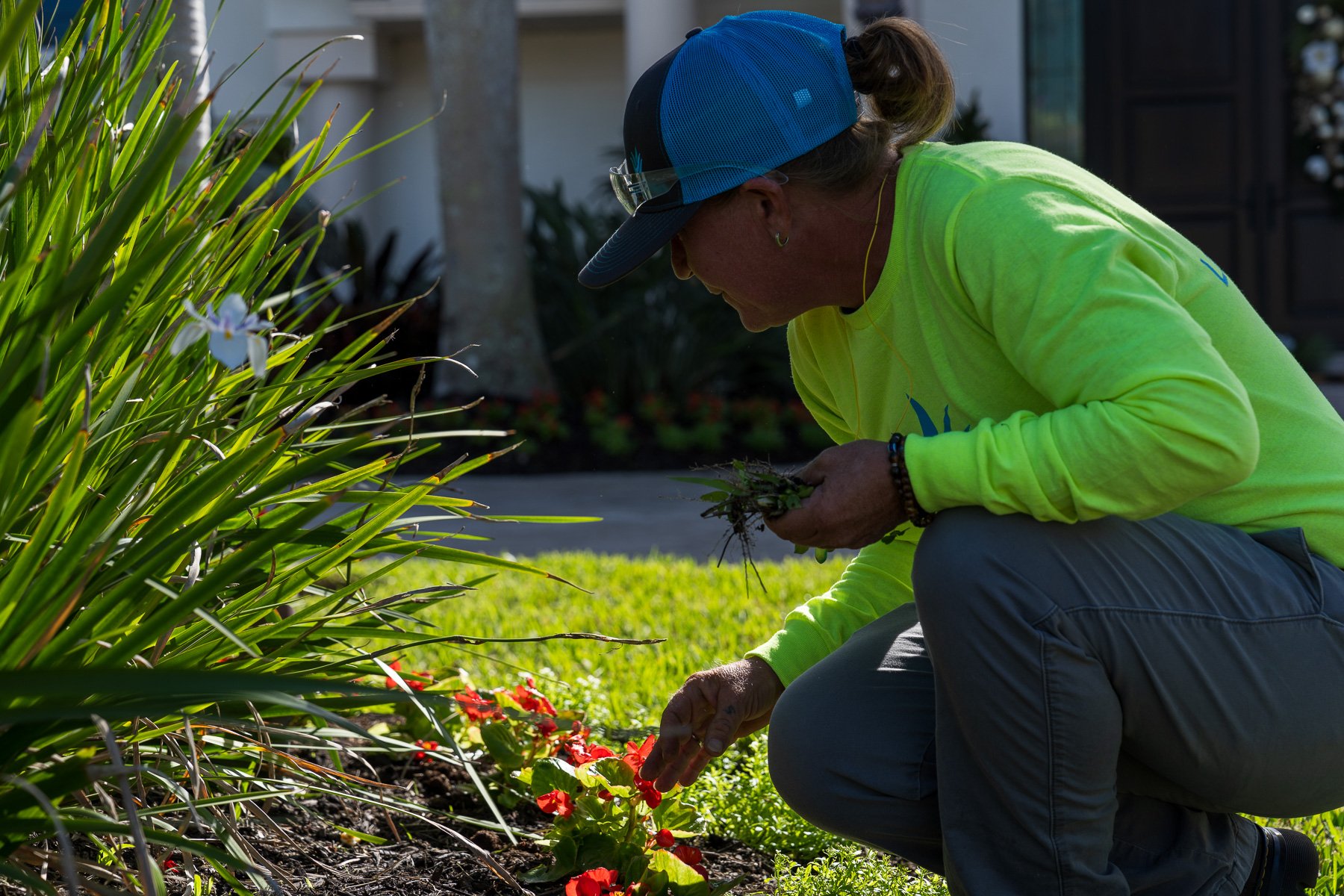
Design Your Perfect Backyard Oasis: Tampa Bay Tropical Landscaping Essentials
 Michael Tomaino
Michael Tomaino
There's nothing quite so peaceful as a blissful oasis all your own.
Picture the breeze gently sweeping across you as you sit beneath a shaded Florida palm. The wind rippling your pool's surface and wafting the scent of Florida-friendly flowers your way.
Enjoying a tropical oasis in your own landscape is never a problem. Building one from the ground up–and then maintaining it–is usually where people start to run into issues.
This is especially true when it comes to the unique challenges that Florida throws at our best-laid landscaping plans.
If you're seeking a landscape of your own that feels like a vacation every time you step foot on the soft grass or perfectly-placed pavers, this is the starting point you've been searching for.

You may not have a cozy hammock to curl up in with a chilled glass of *insert your favorite beverage here* just yet, but after you read this guide, you'll be one step closer to knowing how to create a backyard oasis.
Table of Contents
Essential Elements of a Tropical Landscaping
Implementing Your Landscape Design
Maintaining Your Landscape Post-Installation
Choosing the Right Landscaping Company in Tampa Bay
Your Tropical Oasis Awaits–Landcrafters Can Help
Planning Your Landscape Oasis in Tampa Bay
Before you can dive into the logistics of setting up your paradise, you need to get to the root of what your version of paradise looks and feels like.
Like any good ideal outcome, your oasis needs a plan of action. And every good plan of action starts by getting organized.
Here are a few go-to steps you should take as soon as you decide you're going to pursue a Tampa Bay oasis in your own backyard.
Curate Your Favorite Backyard Oasis Ideas
First things first, you need a vision! Otherwise, what oasis are you actually working toward?
Find examples of landscapes you love or backyard setups that look like the paradise you're seeking for your own space.
Pull together a vision board of sorts in one place so you can get a feel for what your ideal oasis looks and feels like.

Set Goals for Tropical Landscaping
Ask yourself: what's the real goal of my outdoor oasis? Are you creating a space where you can relax without interruption?
Are you hoping to curate a space that turns into the go-to party spot for all your friends and family?
Do you want to put together the ultimate Florida play area for your kids or grandkids?
Having a firm foundation for the purpose of your landscape can help guide the design (and maintenance) process to ensure you're getting what you really want in the end.

Audit Your Space
With your vision and your goals in mind, take a good, hard look at the landscape you're working with.
Run an audit of the landscape to get clear on what your landscape is really like:
- How much sunlight does your space get?
- What's the terrain like?
- Is there a split in sunlight and shadow?
- Is there lots of open space to work with?
- Do you need to get creative with existing vegetation?
- How does the health of the soil or grass seem?
- Have things successfully grown here before?
- Which thrives better in your space–annuals or perennials?
A realistic understanding of your space can help guide the process and create a clear picture of what kind of oasis you can create.
Determining Functionality vs. Aesthetics
Start brainstorming ways to balance aesthetics with functionality with your backyard oasis ideas. How can you merge beauty with usability in your design? Are there unique ways you can add aesthetics and functionality at the same time?
Start tying these strings together before the planning process really takes shape–this way you can set goals that achieve multiple purposes.

Consider Florida's Unique Conditions for Your Backyard Oasis
Like any other state, Florida has special conditions you'll need to address before you create the oasis of your dreams.
Florida has harsh heat, steamy humidity, lots of rain, and plenty of sea salt in the air. Creating an outdoor space for Florida's climate and conditions can be challenging.
In the process of thinking through and planning for your landscape, you'll want to consider flora and fauna that align with Florida's conditions.
Native plants, Florida-friendly trees and shrubs, and hearty, salt-tolerant additions are all must-consider elements.

Essential Elements of Tropical Landscaping
You've got your vision board, taken a thorough audit of your own space, and are on a mission to balance beauty with functionality.
Now what?
Once you've mapped out what you want your space to look and feel like, you can move on to include your list of non-negotiables (or essentials) for your space.
Here are a few things we think every soon-to-be-oasis enjoyer should consider for their backyard paradise.
Florida-Friendly Plants & Trees
Beyond the fact that native plants, durable trees, and hearty flora and fauna will perform best in Florida's wild and somewhat unpredictable climate and conditions, there's simply something to a Florida-fied outdoor oasis right outside your back door.
To fully capture the Florida feeling you're chasing, you'll want to opt for the lush, tropical flora and fauna Florida already offers.
What do we recommend? Plenty of palm trees, of course, big shade trees for the perfect balance of sunshine and solace from it, and salt-tolerant beauties like Oleander, Salt Spray Roses, and Beach Sunflowers.
Of course, intentionally choosing Florida-approved flora and fauna is one of the soundest ways to protect your investments (these tough plants can stand up to Florida's wild-wild west weather).

Hardscaping for Functionality
A stunning oasis isn't just beautiful; it's functional–and that starts with where you step. You'll need to consider what your hardscaping might look like in this space.
Will you opt for cement pavers for unique walkways? A full-scale brick section for tropical patio ideas?
Do you plan to have a gazebo or cabana for additional shade? If so, what kind of hard structural features are necessary for your space?
Poolside Luxury & Exclusive Experiences
If you're planning your oasis in a landscape that features a pool, we highly recommend theming your vision around that lush luxury.
Whether you're turning your poolside paradise into a calming Zen garden or a resort-style experience, you'll need to consider a few more additions to your space.
For starters, privacy features are an absolute must. Privacy fences can work, but if you're striving for a lush, natural look, you'll want to experiment with natural landscaping for premium privacy.
But more than that, you'll need to consider things like:
- Hardscaping and softscaping for safety
- Adequate drainage to avoid flooding
- Plants and shrubs that thrive near salt water or chlorine

Irrigation is a Must
A functional and thoughtful irrigation setup is non-negotiable in every tropical landscape design. We get it; this isn't the most "fun" piece of the planning puzzle, but the long-term success of your outdoor oasis lives on and dies with your irrigation system.
Investing in irrigation planning means protecting your landscape from harm (and protecting your initial investment, too).
As we mentioned, the Florida climate is anything but predictable. A reliable, automated irrigation system that keeps things hydrated and healthy is a must for any backyard tropical oasis.
Irrigation is part of a much bigger conversation surrounding your oasis–maintenance. Proper maintenance is the answer to ensuring your oasis survives and thrives (but we'll talk more about that in a moment).

Special Touches to Elevate it All
Water features, decorative rocks, stones, and lights for ambiance–these little elevated touches are crucial for leveling up the luxury in your outdoor oasis.
Consider additional touches like granite rock, crushed shell, river rock, lava rock, cedar bark stone, and more to add a little something extra to the look and feel of your space.
What about fire pits? Outdoor kitchens? Extra shade structures like cabanas? Fountains? Hot tub patios?
And of course, you'll need to think about lights! Lighting is so vital to elevating your space, too.
Without adequate lighting in your space, the fun stops when the sun goes down–and we're pretty sure you want to be able to enjoy your space at all hours of the day and night.
Think about twinkling bistro lights, festive tiki torches, or even soft pool lights to shine a light on your epic oasis–even when the sun tucks in for the evening.

Implementing Your Landscape Design in Tampa Bay
With all the essentials in mind and your dream board leading the charge, you're ready to implement and install your very own tropical landscape design.
But before you take trowel to soil and start planting your Florida-friendly flowers, we want to share a few must-know DIY tips with you to ensure you find oasis success from start to finish.
DIY Installation Tips for Tropical Landscaping
Are you a DIY kind of person? We respect that and can't wait to see what your backyard tropical oasis looks like.
If you're cool with it, we want to share a few DIY tips from our decades of experience to help your process go smoothly.
- Create a blueprint for your workflow.
- Always, always, always start with irrigation.
- Focus on function first, then form.
- Remind yourself as you plan and install–you'll have to maintain everything you add.
- Plan your plants before you start the process.
- Supplement annuals and perennials.
- Balance texture and color to keep things interesting.
- Consult pros (your local Tampa landscapers or YouTube) when you get stuck.
- Ask for help–adding a pair of hands to the mix can make it more fun.
- Keep your eyes on the prize, and have fun putting it all together!

When to Call an Audible: Bringing in a Pro Tropical Landscape Design Team
Signs It's Time for the Experts
If you're experiencing any of these symptoms during your landscaping install process, it might be time to call in a team of pros to help you out:
- You feel like you're in over your head and have no idea how to press forward.
- The costs saved start to matter less than the time you're spending trying to perfect it all.
- Your plants aren't thriving, and you're not sure what's gone wrong.
- Your oasis becomes a magnet for stress (that defeats the purpose of the tropical oasis!)
The Benefits of Hiring a Pro Tropical Landscaping Team
We'll call this out immediately.
Initially, hiring a pro landscaping team to tackle your tropical oasis could cost more than if you DIYd it yourself.
We fully understand that being able to cut back on costs is a mark in the "pro" column for creating landscaping on your own.
That being said, there are some hefty benefits to investing in tropical landscape pros from the start, like:
- The process from start to finish is often quicker, getting you in your tropical oasis ASAP.
- Less stress and hands-on effort on your end. If the oasis is meant to be a relaxation zone, it might mess with the mojo if the design and installation were overly stressful.
- Pros do things right the first time, helping you avoid potentially costly mistakes.
- Designers and installers have lots of experience and know plenty of tricks to cut costs.
- Pros have years worth of experience and vision to share with you–your space could look better than you ever imagined.
- In most cases, they can provide maintenance for the landscape they installed.

Maintaining Your Landscape Post-Installation
What Goes Up Must Come Down: Your Design Needs Maintenance
Unfortunately, designing, installing, and enjoying a tropical oasis is just half the experience.
When you're in the process of creating a stunning outdoor space that's all yours, it can be tempting to design without constraints. You're reaching for the stars with your concept because you deserve something breathtaking, right? We agree.
Here's the thing. When you shoot for the stars and fly high, gravity eventually brings you back down to earth–and if you've designed a tropical oasis with an out-of-reach landscape maintenance plan, your oasis can come crashing down around you.
Maintenance should be considered from the moment you start planning out your vision of the perfect oasis. Ongoing, regular landscape maintenance is what keeps that lush oasis, well, lush.
Proper pruning, regular mowing, caring for flower beds, mulching, palm tree trimming, shrub maintenance, irrigation monitoring, and seasonal flower shuffling–all of these are pieces to the maintenance puzzle that make or break the health and well-being of your oasis.

And of course, there are always Florida-specific seasonal condition concerns to deal with, too, like hurricane-proofing, winterizing, and beyond.
Knowing how and when to water your tropical oasis, when to get rid of your stormwater runoff, and even how to manage pests properly are all key parts of maintaining your perfect little oasis.
The Benefits of Professional Landscape Maintenance
Though there are plenty of DIY maintenance tasks you can accomplish on your own, like regular mowing, seasonal trimming, and consistent irrigation.
But realistically, most homeowners don't have the time, energy, or equipment needed to provide a tropical oasis with all the maintenance needed to stay lush and luxurious.
Hiring a pro team to help you tackle the big, small, and in-between maintenance can ensure that your tropical paradise starts and stays just that–a paradise.

Here are a few benefits of working with a qualified landscaping team for your tropical oasis landscape maintenance:
- You don't have to purchase, store, and maintain the tools, equipment, and supplies needed for the ongoing maintenance of your oasis.
- Pros know how to spot early signs of issues or trouble that can eliminate a bigger problem.
- Landscaping maintenance experts have seasonal knowledge that you might not–they can prepare your landscape for whatever that season's conditions might bring, saving your investment from damage or danger.
- It's their job to provide consistent and qualified care. Even if you're completely capable and thoroughly enjoy maintaining your oasis, it's likely you have a packed schedule that keeps you busy. Pros ensure the job gets done on time, every time.
- Pros have years of experience in helping plants, flora, and fauna thrive–they know the secret to keeping your blooms beautiful all year long.
- Your property will hold its value and have a boosted curb appeal with a regularly maintained landscape.
- You get your free time back to simply enjoy your oasis without spending hours in the sun to keep it pristine. When you step outside to enjoy it, the work is already done.
Choosing the Right Landscaping Company in Tampa Bay
Think you're ready to design, install, and enjoy the tropical oasis of your dreams? Working with a qualified team to make that dream a reality is a fantastic first step.
But how can you know if you're hiring professionals who can get the job done right? And further, what can you expect from working with a qualified team in the first place?
Here are a few questions every discerning homeowner should ask before hiring a landscaping team to tackle their tropical oasis:
- How long have you been working in Tampa Bay, specifically?
- Is your team licensed? Certified?
- Talk to me about irrigation–how do you address it and how important is it in your design, installation, and maintenance plans?
- Do you only offer design and installation, or will you also offer maintenance plans?
- What does your spectrum of services cover?
- Have all of your employees undergone background checks?
- Talk to me about your company culture–what's important to your team?

Your Tropical Oasis Awaits - Landcrafters Can Help
That tropical oasis is sounding pretty perfect right now, isn't it? Don't let the potential struggles and obstacles stand in the way of that relaxing-in-paradise feeling you could have in your own backyard!
Even though it might sound overwhelming to go from open space to oasis in your space, it can be done–especially when you work through each step practically. Teaming up with a qualified Tampa Bay landscaper
When you work with Landcrafters–your go-to team for landscape design and installation in Tampa Bay, FL–the stress melts away (which is kind of the point of a backyard oasis in the first place, right?).
Our qualified team has been designing, installing, and maintaining our customers' backyard tropical oases for decades, and we'd be proud to help you craft your very own, too.

Give us a call or fill out our consultation form today! Our Tampa Bay landscape team can't wait to help you create a beautiful, perfect-for-you backyard oasis in your very own space.

Michael Tomaino
Head Gardener for Landcrafters, Inc. Michael Tomaino, a cornerstone of Landcrafters since its inception, oversees all aspects of business operations with a wealth of experience. With years of adept team management and leadership under his belt, coupled with a robust educational background, both within and beyond the industry, Michael is dedicated to steering Landcrafters towards becoming the foremost landscape management provider in the Tampa Bay Area.

